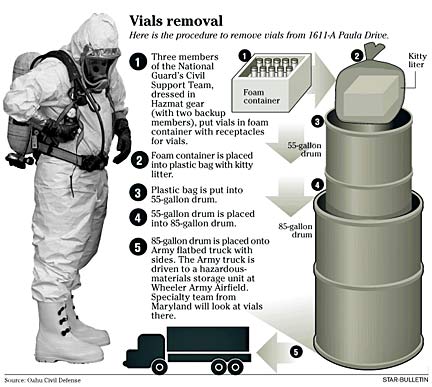
|
Mystery vials
taken to safety
The full-day operation
tests the reflexes of
multiple agencies
Army chemical specialists are working today to determine whether 74 vials of a yellowish liquid retrieved from a Maunalani Heights home are dangerous.
In an all-day operation yesterday, Paula Drive from 16th Avenue up Maunalani Heights to just below Iwi Way was closed while a joint city-state-federal hazardous-materials team retrieved a box of vials discovered last year by Kelly McArthur. They tested her home and the area nearby for hazardous materials. The roadblocks were lifted at 6:30 last night.
The vials were moved to Wheeler Army Airfield, but the operation ran into a minor problem when investigators found what was believed to be an inert mortar fuse in the home. The Army truck picked up the vials and other materials at 7:20 p.m.
Although the city and state have been working and training together on responding to incidents of possible chemical or biological contamination since 1997, yesterday's incident was the first real case involving a possibly hazardous substance -- what some suspected could be vials of mustard gas a half-century old.

Firefighters headed to a meeting yesterday with Army personnel who had set up a decontamination area in the driveway at 1611-A Paula Drive, where vials containing an unidentified liquid were found.
Capt. Kenison Tejada, Honolulu Fire Department spokesman, said the operation went well. "We drill together and drills are really good," Tejada said, "but real-life scenarios are better."
Army chemicals experts were to examine the vials at McArthur's home, but that would have meant that she and the occupants of two neighboring homes would have been homeless until Sunday.
Tejada said members of the Hawaii National Guard's 93rd Civil Support Team were responsible for removing, packing and transporting the vials, which were secured in an 85-gallon drum carried by a red Army flatbed truck. Members of the 93rd team, commanded by Lt. Col. Courtney Veres-Lum, also tested the air in McArthur's home.
It was the job of the Honolulu Fire Department hazardous-materials team to monitor the air outside the home. Also on the scene were four city ambulances and emergency medical technicians, representatives of the state Department of Health, Oahu Civil Defense and the Red Cross.
Homeowners from Paula Drive to Claudine Street were told to either leave or stay inside.

The glass vials were said to be about 6 inches long, 1 inch wide, with no caps, and sealed. They had no distinguishing marks.
Chemical experts from the 20th Support Group at the Aberdeen Proving Ground will identify the vials' contents and recommend what should be done.
Mary Markovinovic, Fort Shafter spokeswoman, said the mainland team was brought in because federal law requires the Army to investigate any substances that are believed to have a miltary origin.
She said the Army was contacted by the state Health Department on Tuesday and asked to participate because McArthur had told the state that she believed the vials belonged to a World War II chemical officer.
Last year, McArthur found a green and red cardboard Christmas box under her house with sealed glass vials containing an unknown liquid. She believes they belonged to Ernest Thomas, a chemical engineer who was a chemical warfare expert in World War II. She had been caretaker for Thomas and his wife.
Cummings said McArthur "did the right thing by reporting it and not throwing the vials into the garbage can."
The drum holding the vials, plus another holding other potentially hazardous materials, were washed with soap and water before being loaded onto the truck.
All the workers wore full-body decontamination suits, including special breathing apparatus. National Guard soldiers were outfitted in light brown, firefighters in orange and blue, and emergency medical technicians in silver.
Since Tuesday the box of vials, which was packed with kitty litter, was being protected only by a gray city trash bin that had been placed over the box outside of McArthur's home.
Cummings said there were numerous state and federal regulations that had to be met before the vials could be moved, including certain requirements laid out by the U.S. Department of Transportation.
[News] [Business] [Features] [Sports] [Editorial] [Do It Electric!]
[Classified Ads] [Search] [Subscribe] [Info] [Letter to Editor]
[Feedback]
